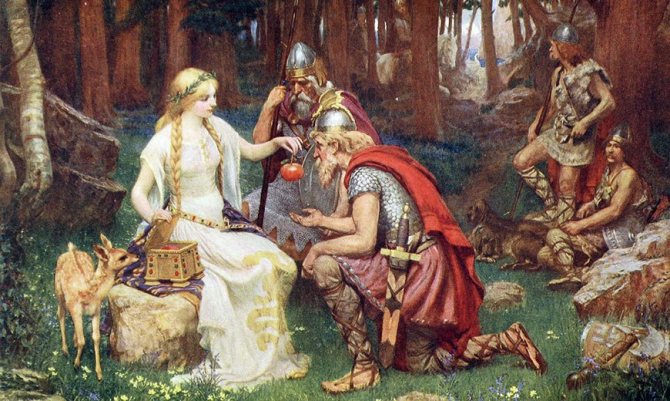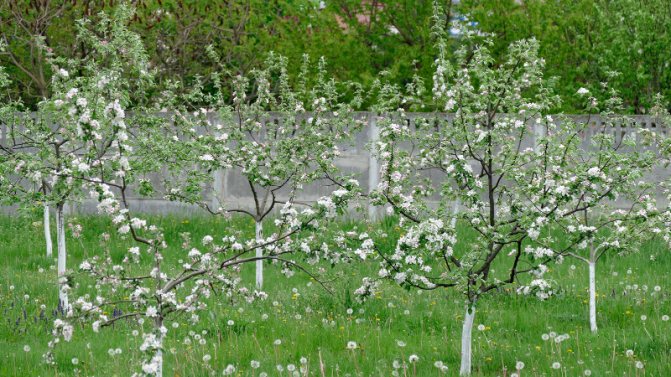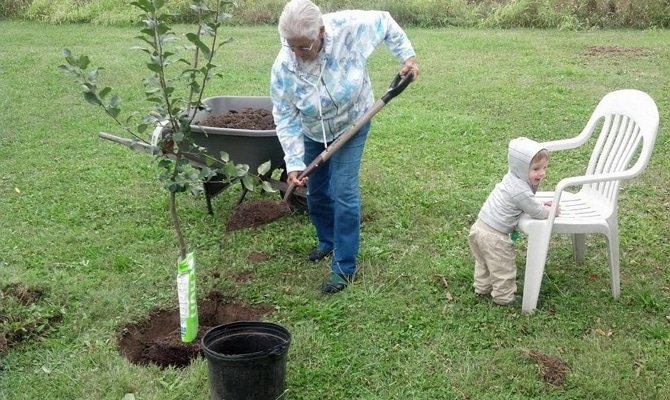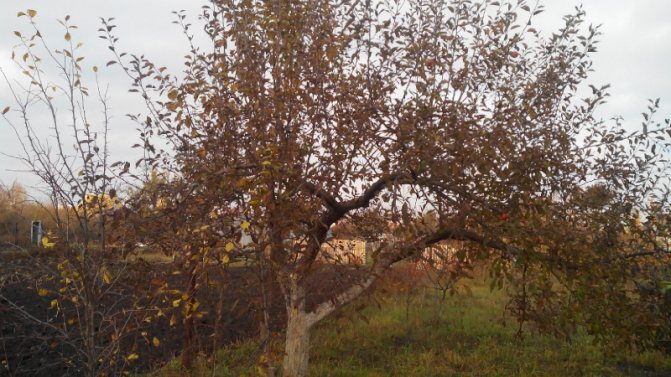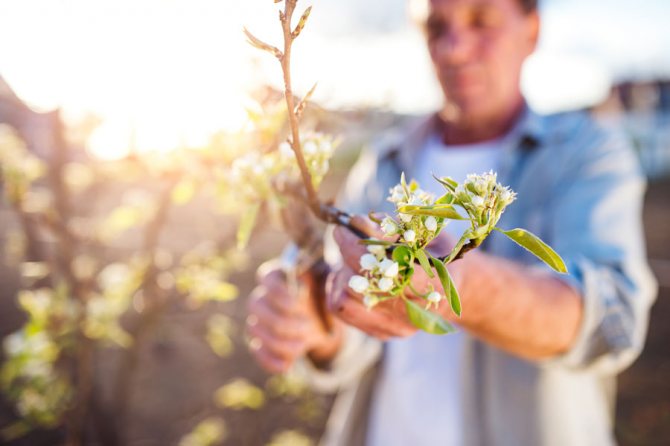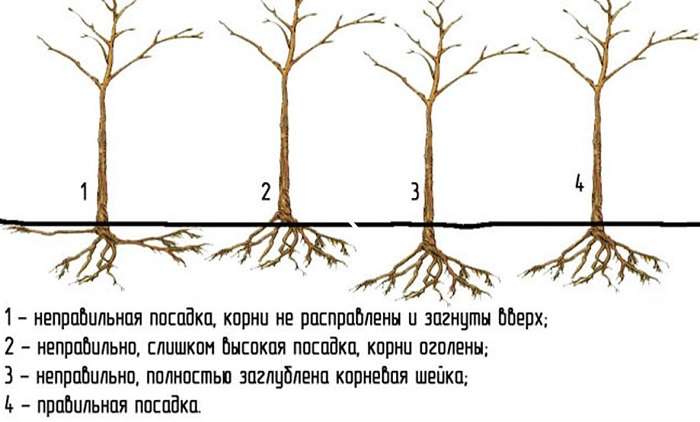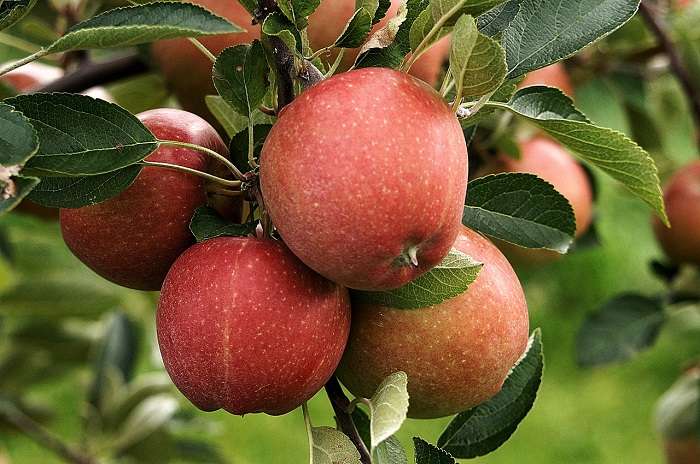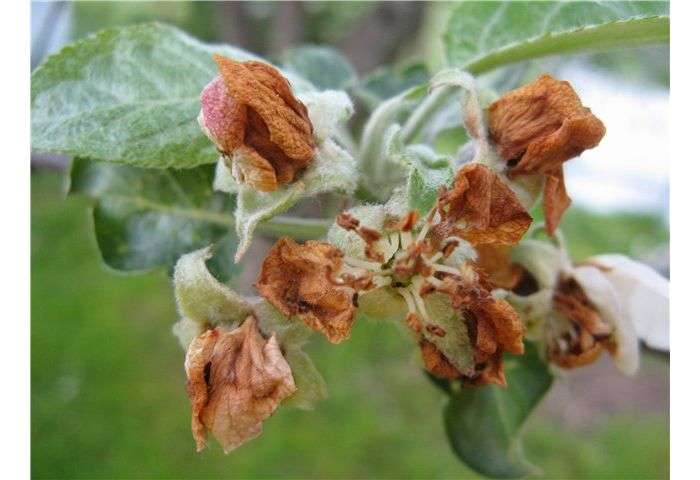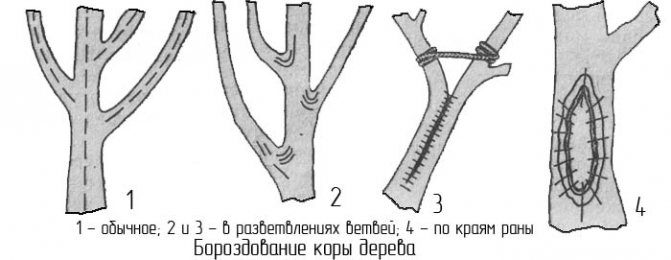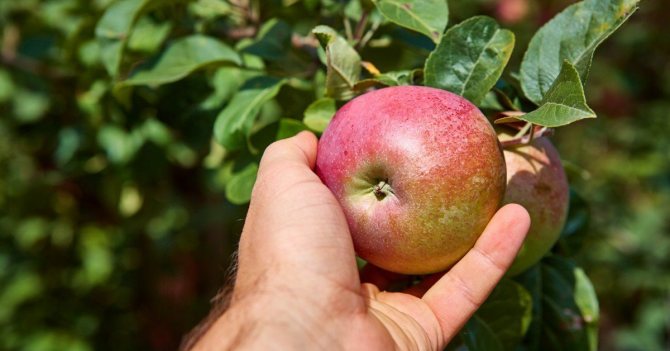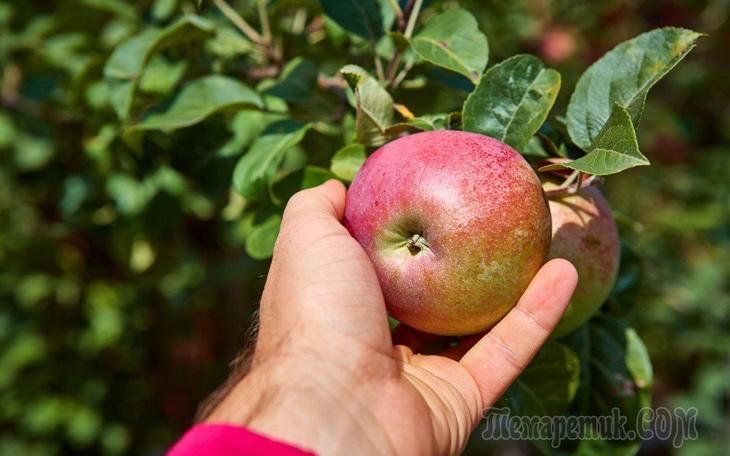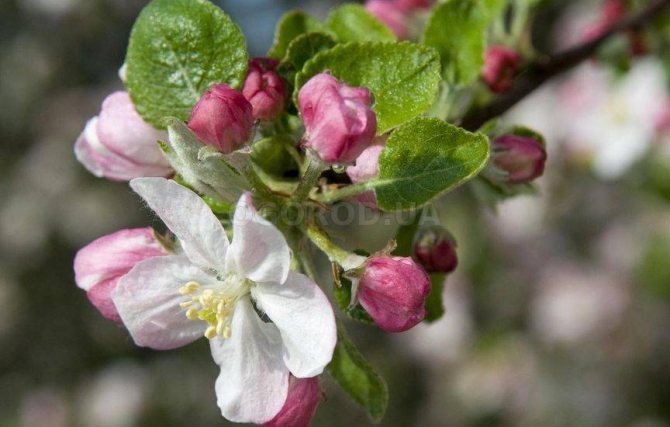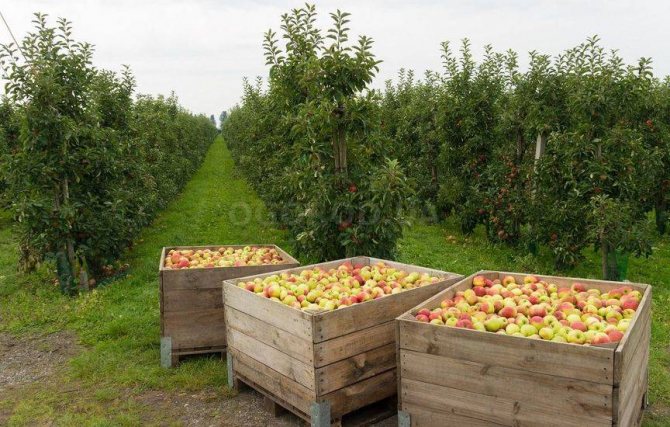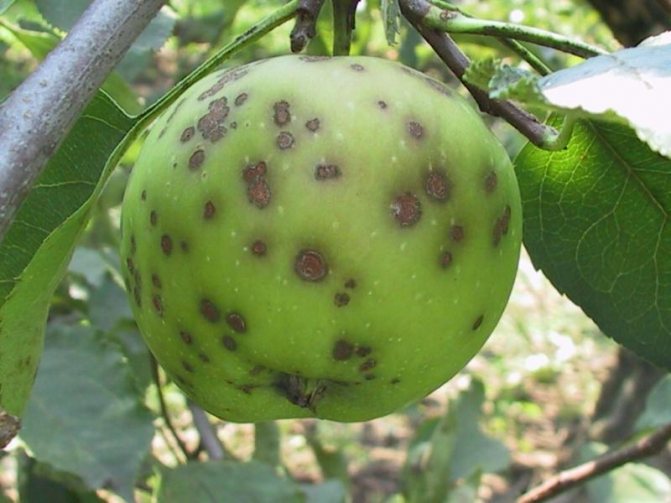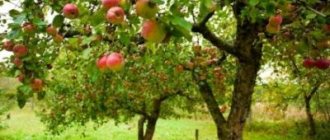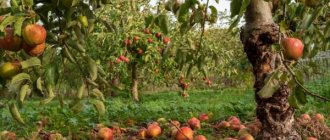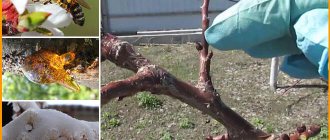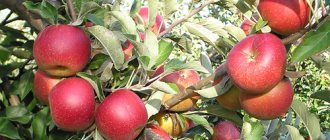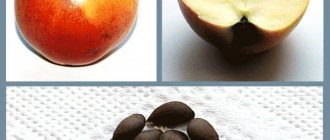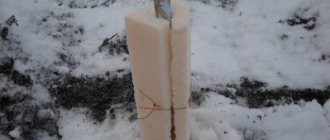The apple tree blossomed, but there will be no apples again, gardeners lament - and they buy new apple tree seedlings, and when planting and caring for apple trees they make the same mistakes as before. Why didn't the apple tree bloom in spring? And if it bloomed, why did all the ovaries fall off? The book "The Bible of the Orchard" contains answers to these and other questions about fruiting apple trees, as well as tips for pruning apple trees in summer for a good harvest next year.
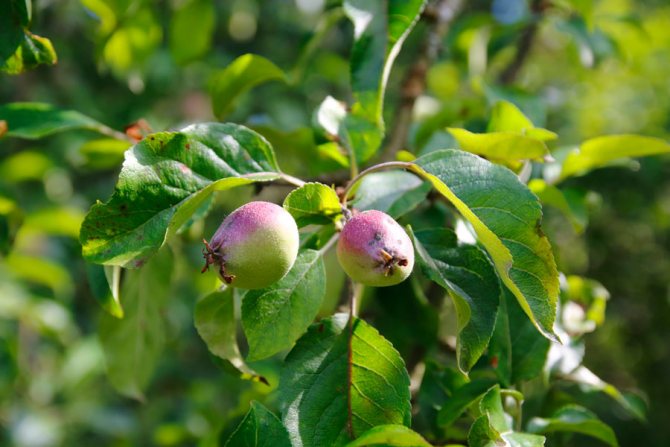
For what reasons can an apple or pear tree refuse to bear fruit, although by age and size it should have been strewn with them for a long time? There can be several reasons for refusing to bear fruit - as a rule, they consist in mistakes when planting an apple tree and caring for it.
Apple tree - description
The apple tree belongs to the genus of deciduous trees and shrubs up to 10 m high. This garden culture grows almost throughout the Northern Hemisphere. The apple tree is grown mainly for delicious and incredibly healthy fruits. In total, there are more than 60 types of apple trees in the world.
Apple trees are conventionally distinguished into fruit and ornamental. For example, some types of apple trees are specially grown for decorating gardens and parks. The apple tree is also known in the carpentry business, as its wood is well cut and polished.
By height, apple trees are conventionally divided into tall, undersized, dwarf and semi-dwarf.
In addition, apple trees differ in crown type. This is a very important factor for gardeners, since when breaking up a future garden, you need to understand its future geometry. Crowns are:
- Sprawling. A mature tree covers a large area of the garden and provides a lot of shade.
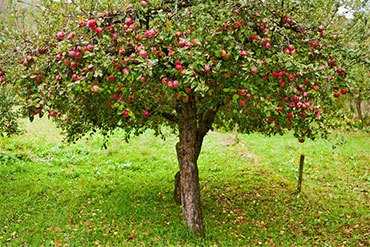

- Weeping. Incredibly beautiful ornamental plants. In spring, weeping apple trees are literally strewn with delicate pink flowers. In summer, the purple foliage is beautiful. And in autumn, in addition to the spectacular reddening foliage, the apple tree shows branches hanging under the weight of small fruits, which can become an excellent winter feeder for birds.
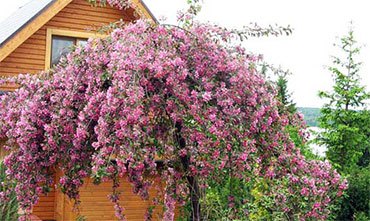

- Columnar. A very interesting option for gardeners, since the tree grows in one trunk, and the branches stretch upward. A tree-column covered with apples takes up a minimum of space and bears fruit well. The disadvantage is that it does not tolerate frost.
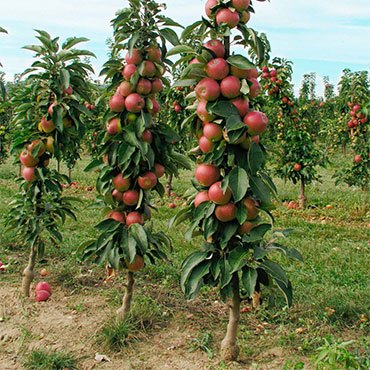

All types of apple trees are good honey plants.
Apple tree - breeding history
Man has always eaten wild apples. Apples are mentioned in the Bible, in Greek mythology, and in fairy tales. This fruit has always been very important to humanity. In addition to the practical benefits, the fruits of the apple tree also had a great sacred meaning. Everyone knows such philosophical concepts as "the apple of discord", "golden apples", supposedly giving youth, and of course, "apples of paradise", granting immortality.
The cultivated species of the apple tree appeared much later. From historical sources it is known that the birthplace of apple cultivation is the territory of modern Kazakhstan and Kyrgyzstan. There is also a lot of historical evidence that this plant was highly valued in Ancient Greece. Famous writers and philosophers of that time in their writings mention 36 varieties of apple trees.
In Russia, the first apple orchard appeared under Yaroslav the Wise. Since the 16th century, the home apple tree has spread to the northern latitudes of our country.
Apple tree - planting
Proper planting is the key to successful growth and a good harvest in the future. This general rule applies, of course, to the apple tree as well. Compliance with some simple rules when planting will allow the plant to root well and develop in the future. Otherwise, you may never get the desired apple harvest.
So.
The apple tree prefers well-lit places. It is advisable that there are no large trees nearby.
Soil selection. The soil should be fertile, loose, with a neutral reaction. The apple tree does not like areas with a high groundwater table (at least 1.5 m, and for tall varieties at least 3 m). The root system of the apple tree is strong, fibrous type. The depth of the roots depends on the variety and the growing region. But in any case, this plant does not like stagnant water. The formation of the root system can take up to 20 years.
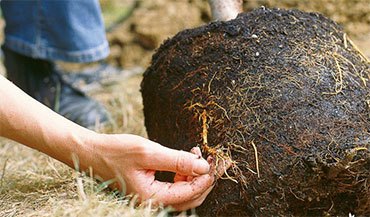

Preparing a planting pit for an apple tree
A planting pit for an apple tree is prepared in advance (10-14 days in advance). Pit dimensions - 100 cm - diameter, depth - 60-70 cm.
The soil for the planting pit should contain humus, rotted manure, peat and compost. In the absence of any of the components, you can mix any of the available components with fertile soil. If your area is clayey soil, you need to add sand. And vice versa, peat, humus, compost should be added to the sandy soil.
As for mineral fertilizers, many experienced gardeners advise against applying them when planting. Very often, an excess of chemicals has a detrimental effect on young apple trees.
When the soil in the hole settles in a few days, you can start planting. A pit for an apple tree digs according to the size of the root system. Then a peg is placed in it, and then a seedling. An important condition: when planting, the root collar should be 4-5 cm above the soil level.
A young tree needs to be tied to a peg, and the soil around it should be well tamped.


After planting, a young apple tree should be well watered at the rate of 3-4 buckets per plant. And then the trunk circle is mulched with peat.
If you are planting a whole apple orchard, then the distance between the seedlings should be:
- vigorous varieties - 4 m, distance between rows -5-6 m.
- For low-growing varieties - the distance between seedlings and rows should be 3.5 m.
- For undersized and dwarf varieties - 2.5 m.
Time to plant apple trees
The question of when is it better to plant apple trees - in autumn or spring - is controversial. Here the opinions of agronomists and gardeners are divided. Recent disputes boil down to the fact that you need to focus on the growing region. The dormant period for plants in different climatic zones begins in different ways.
For example, in the south of our country, it is better to plant young apple trees in the fall, about a month before the onset of frost. Depending on the area in the south, this falls at the end of September - end of October. During this time, the apple trees have time to take root and gain strength for wintering.
In the northern regions, as well as in Siberia and the Urals, it is advisable to plant in the spring, since the autumn weather here is partly unpredictable, and young plants may not withstand sudden frosts. When planting in spring, the survival rate of plants is better. Planting should be done while the young plant is dormant.
In the central regions of Russia, planting is carried out both in autumn and spring, focusing on the weather.
How to choose the right apple seedlings
The choice of apple variety is a very important issue. Choose only those varieties that already grow in your area. If neighbors presented the apple tree sapling to you, you shouldn't worry. It's another matter if you are offered to buy some elite variety from overseas countries. The temptation is great, but still it is not worth the risk. Remember that you are choosing a tree variety that should grow and bear fruit for years.Therefore, you need to choose only zoned apple varieties adapted to your region. It is best to buy apple seedlings in the nearest nursery or gardening.
The next thing worth paying attention to is the timing of fruiting. Remember that summer apples ripen approximately in July-August, autumn apples with the onset of autumn, and winter apples later, depending on the variety and region.
The best seedlings for planting are seedlings 1-2 years old. They take root easier and get sick less. Outwardly, the age of seedlings can be determined as follows: annual apple trees do not have developed branches. Biennial seedlings have 2-3 branches growing at an angle of 45-90 degrees.
Also, when buying, you should pay attention to the state of the root system. The roots should be white when cut and healthy. A gray tint means that the roots are frozen or rotted. The optimal root length is about 30 cm.
You should not buy seedlings that have various kinds of swelling and formation on the roots or stems. This could be a sign of a medical condition. Also, the roots should not look dry.
Apple tree care
Apple tree care is simple, but still necessary. It consists of regular weeding and loosening of the trunk circle. It is advisable to loosen the soil with a pitchfork so as not to damage the roots.
If you did everything correctly when planting, you can not feed the young apple tree for 2-3 years. Then feeding should be done regularly. Top dressing should be alternated with mineral and organic fertilizers. Their frequency and quantity depends on the type of soil in your area. Water the apple tree as needed.
However, the most difficult maintenance is pruning and shaping the crown of the tree. Regular pruning is essential for proper plant development and good fruiting. In order to form the correct crown, pruning of the apple tree is carried out at the age of 2 years. To do this, you need to leave 2-3 skeletal branches on the trunk, directed in different directions.
Annual crown formation begins 2-3 years after the first pruning. This is done as follows: all branches that have grown below the first skeletal branch are removed. Branches growing upward are also removed so that a thickening of the crown does not form. Sore and broken branches also need to be removed. It is preferable to prune the apple tree in the spring, before the sap flow begins.
Prevention and advice from gardeners
Preventive measures should be taken every growing season, depending on the season. Experienced gardeners are developing a system of measures aimed at improving fruiting. This includes regular feeding of trees, treatment for diseases and pests.
In addition to traditional methods of increasing yields, gardeners use scientifically unsubstantiated, but no less effective methods. For example, many amateur gardeners recommend sticking to the lunar rhythms when planting apple seedlings. So it is believed that the apple tree needs to be planted in a permanent place a couple of days before the new moon.
Another interesting folk method of harvesting is the intimidation method. You need to take an ax, go to the apple tree and threaten that you will cut it down if it does not yield a crop. Many gardeners note the success of this method and advise others to try.
Caring for columnar apple trees: what to do if the tree does not bear fruit and does not bloom.
Planting a columnar apple Feeding a columnar apple Pruning Leaves care Weed control In almost any garden, be it a small area or a chic space, there is always a little room for beautiful columnar apple trees. These compact low trees will become not only the real color of your site, but will also be just a treasure of all kinds of vitamins and minerals.Of course, in order not to be disappointed in the chosen variety, it is necessary, first of all, to observe the correct care of columnar apple trees, which includes several points at once: - correct planting; - timely feeding; - trimming; - leaf care and disease prevention; - weed control, etc. Planting a columnar apple tree In order not to ask the question "Why a columnar apple tree does not bear fruit", you need to make every effort and follow all the recommendations for caring for these trees, an important point among which is the planting of seedlings. During the transfer of future trees to the planting holes, do not forget to "pamper" them with 3-4 kilograms of humus or compost. Such a large amount of fertilizer will also save you from the need to pick off blossoming buds in the first year of the tree's life. The use of growth regulators will help you to stimulate the process of good root formation, but in no case, do not use full mineral fertilizers for this. Top dressing of a columnar apple Very often pondering why a columnar apple tree does not bear fruit, gardeners come to the conclusion that the reason for everything was the lack of top dressing. But this process plays an important role in the life of these plants. For example, in order for an apple tree to bear fruit well, it must be fertilized with urea. Moreover, this process is carried out before the formation of small fruits. One apple tree consumes about 2 liters of a solution prepared in a proportion - 50 grams of fertilizer per bucket of water. The first time it is necessary to sprinkle trees with such a "drink" immediately after the leaves have opened. The next 2 similar procedures are performed with an interval of 2 to 3 weeks. As foliar dressings, you can also use the same urea solution, making it weaker - no more than 10 - 20 grams of dry matter per bucket of liquid. Pruning This step will not take you much time, since columnar apple trees do not need to create a crown at all. You only need to cut the strong side shoots into 2 - 3 buds. You can also trim the top of the apple tree a little, which will greatly improve its fruiting. Leaves care The leaves of any plant are like a kind of factory for processing the energy of sunlight into useful organic matter. That is why it is not surprising that caring for columnar apple trees also includes taking care of the green crown of the trees. Apple leaves should always be kept clean and healthy. It is also unacceptable to damage them by all sorts of pests and diseases. To accomplish this task, spraying and other similar procedures are perfect, which are more than simple to carry out on a columnar apple. Among the main pests that infect columnar apple trees, one can distinguish the weevil, which gnaws the apical bud, as a result of which it begins to branch. If this has already happened, you will have to pinch the side shoots. You can fight other harmful insects in the same way as in the case of other crops, that is, using special preparations that must be sprayed on the leaves of the apple tree. Weed control Some novice gardeners may scornfully look at this point and very in vain, since weeds are perhaps the worst enemies of the columns in the struggle for moisture and various nutrients. In order to avoid the "suffering" of the apple tree, it is necessary, of course, to prevent the growth of weeds on the trunks. The only correct way in the conditions of a summer cottage will be regular hand weeding. You should immediately pay attention to the fact that it is better not to use digging for these purposes, since this is fraught with damage to the root system. In the aisles, you don't have to bother and just periodically mow the grown grass.Following these simple, simple tips will help you grow healthy fruit-bearing trees that will delight you with juicy fragrant fruits for a long time. If your apple tree does not bloom, has ceased to bear fruit, or its external condition has worsened, make sure that all the above points for caring for the plant have been completed and as soon as the cause is found and eliminated, your favorite apple tree will again begin to delight you with a generous harvest.
Columnar apple trees, in common parlance, just columns - these are apple trees that do not form lateral branches.
Their trunk and skeletal branches are simply overgrown with short fruit branches.
Very often, gardeners, after acquiring seedlings of columnar apple trees, are faced with a lack of fruiting in them.
This phenomenon can be attributed to several main reasons.
Why does the columnar apple tree not bear fruit, what should I do?
The reasons
Of the main reasons for the lack of flowering and as a result of fruiting, the following should be noted:
- Low quality planting material. Very often, under the guise of seedlings of columnar apple trees, they sell anything. It can be both unknown varieties from the vastness of Ukraine or Moldova, and wild; Attention! It is necessary to purchase seedlings of columnar apple trees only in specialized shopping centers and nurseries, only in this case it is possible to guarantee their compliance with the declared variety and quality.
- Abundant branching is another fairly common reason for the lack of fruiting. Most often this happens when there is no correct pruning. In ordinary varieties, the lateral branches move to the sides and form a spreading crown; in columnar varieties, they rise upward at an acute angle. If the columns are not cut off in time, then by 5-6 years of cultivation they form a massive crown with a diameter of up to 1.5 meters. Now there are varieties in which lateral branches are not laid at all, it is they who should be given preference when choosing seedlings;
- Freezing. Freezing of the apical bud can also be the reason for the lack of fruiting. In this case, the main trunk ceases to grow upward, and the lateral continuation shoots begin their development;
- Insufficient winter hardiness of seedlings. If the winter hardiness indicators are low enough and the variety is not zoned for the growing region, then abundant fruiting can not be expected.
Decision
Knowing why there are no fruits on the columnar apple, you can apply several basic measures to eliminate this problem:
Correct and timely pruning
The scheme for the formation of a columnar apple tree is quite simple. On it, the shoots that bear fruit last year are cut off annually to the level of 2-3 buds. Over the summer, they will give good growth and will lay flower buds for the next year.
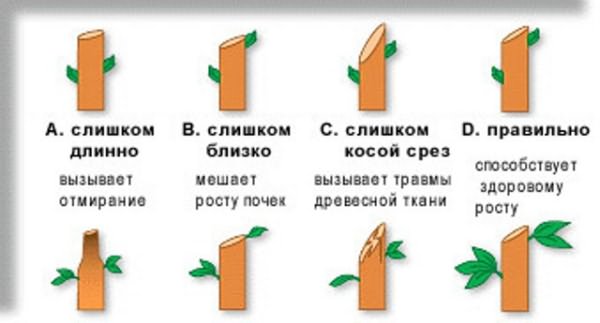

How to make the right cut when pruning.
In cases where the apical bud was damaged by frost and after that lateral shoots began to grow abundantly on the crown, a different pruning scheme is used. Of all the shoots, the most developed is selected, and the rest are simply cut out.
Organization of a winter shelter
Most column varieties are designed to be grown in relatively warm regions with mild winters, so they freeze slightly in the middle lane. Young 2-3 year old trees are especially affected by winter frosts.


Columnar apple trees need shelter for the winter.
To help the trees survive the winter, their crown is wrapped in several layers of covering material, and in its absence with burlap or rags. For greater reliability, even the root zone of the tree is insulated.
Advice! A layer of straw or sawdust is used as a heat-insulating material.
Top dressing
A lack of nutrients can also lead to a lack of fruit. To prevent this, apple trees must be fed according to the following scheme:
- In the spring, until the buds bloom, urea is introduced into the root zone with subsequent embedding. You can replace it with a layer of well-rotted compost or manure;
- In early summer, at the time of ovary formation. At this time, apple trees are fed with a complex mineral fertilizer;
- In late summer - early autumn, trees are fed with potash fertilizers. They contribute to better ripening of shoots and significantly increase winter hardiness.


Types of potash fertilizers.
Ovary rationing
Columnar apple trees have the ability to form a very large number of ovaries. If they are not normalized, the tree gradually depletes and eventually dies. To prevent this, in the first 2-3 years of development of the tree, the ovaries are thinned out on it:
- In the first year after planting, remove all formed ovaries;
- On the second - no more than 50% is left;
- On the third, only one third is removed.


Flowering columnar apple trees.
Important! Columnar apple trees have the ability to increase the volume of fruiting annually. So that the quantity is not at the expense of quality, in the future it may also be necessary to remove part of the ovaries. A signal for this is a strong crumbling of the fruit.
Watch the video why the columnar apple tree does not bear fruit:
It is not difficult to achieve full-fledged fruiting of a columnar apple tree in your area. You just need to carefully monitor the condition of the tree and timely carry out all the necessary care measures.
Possible reasons
There are a variety of cases: the apple tree may be young and not bloom, it may bloom, but not bear fruit, or it may give, but very little. Let us dwell on each case in more detail.
Young apple tree
The apple tree has already reached the age when it is time to start bearing fruit (which is usually the fifth year), but nothing happens. In the simplest case, you simply do not have an idea of what kind it is, and in fact the tree may be one of those that begin to yield crops in the sixth or even seventh year of life (Sun, Suislepskoe, Anis Aly, Anis Polosaty, Autumn Striped, etc.).
A well-planted apple tree develops correctly and bears fruit without delay
If you know that according to all estimates, the tree should have bloomed a long time ago, but for some reason is in no hurry to do this, it may have been planted incorrectly. It could be buried too deep, and then he will have to spend more time fighting for survival. Such apple trees are easy to recognize by their slow growth rate, and annual growths generally freeze out.
The tree is seven, eight or more years old
When all conceivable and inconceivable terms have already passed, and there is still no expected flowering, it's time to think about caring for the tree. If you follow all the appropriate measures, then you may be breaking the rules for pruning. For example, inexperienced gardeners often remove overgrown wood in the form of fruit tree branches. These include garden twigs, spears and ringlets.
Growing branches of an apple tree: 1 - spear with a growing apical bud; 2 - spear with a flower apical bud; 3 - fruit twig; 4 - ringlet with a growth apical bud; 5 - ringlet with a flower bud; 6 - fruit bag; 7 - baby; 8 - fruit bags with replacement shoots (a - ringlet; b - spear; c - fruit twig; d - growth shoot)
Do you remember them? If these are the same branches that you have constantly removed until now, then leave them alone, and also refrain from pruning the apple tree for the next year, or even two years. Then take a closer look at where the flowers will be born - the branches that bear them, and are fruit.
It blooms, but there is no harvest or there is very little of it
There may be several reasons for this.
- The most original explanation is the lack of cross-pollination. If there are no other apple trees around, then cross-pollination simply will not occur.This version looks exotic and is quite rare, because, as already mentioned at the beginning, the apple tree in our plots is almost a ubiquitous phenomenon, so such problems can arise only for lonely gardeners living in the wilderness.
- Flower buds may not ripen well. Most often this occurs in southern varieties (Kuban spur, Aydared, Astrakhanskoe, etc.), planted in the northern regions. In this case, the flowers are weak and have a short period for pollination, which significantly reduces the number of ovaries. Also, an excess of nitrogen in the soil contributes to poor maturation of the kidneys.
- Much more unpleasant is the attack of the flower beetle (weevil larvae). Its presence is betrayed by drops of sugary liquid on the buds. After hibernation, a weevil crawls onto branches and lays eggs in flower buds, and then the larvae do their job. The result is dry, underdeveloped buds.
The weevil is capable of damaging up to 100% of flowers in young gardens, so you need to fight it until you win.
Does not bloom and does not bear fruit
And if the apple tree, which used to regularly yielded a crop, stopped bearing fruit?
- It may not bloom if it grows in that part of the site where groundwater is high. Not only will the roots rot, but also the generative buds (namely, they are fruit) will not appear, instead of them the number of vegetative ones will increase, and the apple tree will overgrow with greenery;
When planting, it should be borne in mind that apple trees love the sun, but do not tolerate the wind.
- the simplest reason for the lack of flowering is the old age of the tree;
An old apple tree can be rejuvenated by pruning, but do not be surprised if it completely stops bearing fruit and becomes just a decorative decoration of the garden - after all, age
- lack of iron in the soil (and apples are fabulously useful, largely due to the iron content). There may be very few flowers, and in especially severe cases, they may be absent.
The apple tree bears fruit only on one side
The phenomenon is rather strange, but it has a logical explanation. If you make a mistake when placing an apple tree on the site, then part of it may not be in the best conditions: lack of sufficient lighting, interference from neighboring trees.
It also happens that in early spring the plant received a sunburn. In this case, there is no need to wait on this side in the coming season not only for fruits, but also for flowers.
Sunburn can destroy part of a tree or even an entire apple tree.
A case is possible when diseases or pests for some reason have chosen only part of the tree, but this, as a rule, turns out to be only a temporary phenomenon on the way to the complete destruction of the plant.
Fruiting not every year
Irregular fruiting is a common occurrence in garden plots. And it's good if you just grow good old ringed varieties like Grushovka, Robinovka or Antonovka, which yield a harvest in a year. But it also happens that the tree itself should bear fruit regularly, but for some reason it does not. This is usually associated with gardeners' mistakes, planting varieties that are created for other latitudes in their own strip. In this case, apple trees do not tolerate winter well, they are easily affected by diseases and insect pests.
Illiterate or lack of care also negatively affects fruiting. The tree begins to age quickly, seeks to quickly leave behind offspring, which translates into an abundance of flowers and a small, sour harvest. After such a season, the apple tree will come to its senses for another 2-3 years.
A pest like a peppered moth, which leaves a tree without leaves, or a disease like a scab, which affects photosynthesis and accelerates leaf fall, make it impossible for an apple tree to plant more flower buds next year.
Scab is a removable problem, there are many varieties that are resistant to this disease on the market by now.
Nobody canceled natural conditions against which it is almost impossible to do anything.Severe winters, frosts during flowering, cold and rain that interfere with the work of bees, severe hail at the time of the development of the ovaries - all this can deprive the crop. However, the apple tree will direct all its efforts to create a huge number of flower buds for the next season.
Fruit quality deteriorates
This is often due to a lack of proper trimming. The abundance of branches leads to a large number of fruits, but the plant does not have the strength to form large juicy apples. So they begin to shrink and lose in sweetness and taste.
For what year does the plum bear fruit? What year should I give birth?
In general, if you take care of a plum according to the rules, then it begins to yield a crop about 5 years after planting. This period depends on the innate characteristics of the variety itself, its pollinators and habitat conditions. As a rule, the first fruits can be expected when the shoots accumulate a specific number of internodes on the buds. The process of their appearance can be accelerated by forming a bush.
In addition, in order to understand how to care for a tree so that it begins to bear fruit faster, you need to know which group it belongs to. Plums are distinguished, which bear fruit on a one-year growth (it is important to maintain the growth of shoots), on perennial overgrowing branches (you will have to constantly thin out the crown) and intermediate (you will have to do both).
Even at the stage of buying seedlings, you should find out whether they will be self-fertile or self-fertile. In the first case, the plant can reproduce only with the help of bees carrying pollen from related plants. Plants must be of a different variety, but ripen at the same time as the one that requires pollination. In the second, its own pollen is used, and pollination occurs independently. In the case of plums, it is recommended to give preference to self-fertile varieties.
In addition, it is important to understand whether the selected seedlings will be compatible with each other, as well as with the existing soil and the existing climate in the area where this fruit is to be grown. Plum is to be planted in well-lit beds in such a way that different varieties (if available) feel comfortable with each other. If the plum is kept in proper conditions, then the harvest can be expected every year.
Finally, it should be borne in mind that this plant can bear fruit for 20 years, after which it will die rather quickly. But some varieties still have lean years, and this is absolutely normal.
Solution of problems
Let's figure out how to make an apple tree bear fruit.
In the case of a young tree, if it is planted incorrectly, you can correct the mistake by transplanting it higher - the root collar should be at ground level.
If we are talking about the removal of overgrown wood, then we leave all of the above, we will not cut the apple tree for the next year or two. We need to give her time to gain strength and direct these very forces to work.
If the apple trees bloom every year, but they do not set fruit or are tied in small quantities, first check with the State Register if your variety is suitable for growing in the area. If everything is observed, we proceed to the excess nitrogen - here you just need to know when to stop. Its main sources are compost and manure - they are used for young trees even before fruiting. As soon as the first flowering has occurred, any nitrogen-containing fertilizing should be canceled, even mulch with grass in the near-stem circle should be avoided. Fertilizers containing potassium and phosphorus are what you need to replace your nitrogen sources with.
Nitrogen fertilizers in the form of compost and manure are good in moderation and only before the first fruiting.
Trapping belts work well against weevils. They are set before the kidneys swell. Late with them - take up insecticides. The first time they are used when the buds open, the second - after the flowering of the garden.It is at this point that the larvae are more vulnerable to chemicals.
Do not try to use insecticides during flowering - along with the pests, kill the helper insects.
In the case of crown thickening, competent pruning will be required, which should be carried out in spring or autumn. The order of deleting branches is as follows:
- get rid of old, dried and damaged branches;
- then from those that grow incorrectly and interfere with others;
- cut off weak and thin branches of the second order (which grow from the main ones).
This pruning improves the fruiting of the apple tree. But the lack of iron in the soil can be corrected with the help of iron-containing preparations like copper sulfate, which should be sprayed on the plant in early spring.
To prevent the apple tree from getting sunburn, take care of whitewashing the trunk and skeletal branches in the fall.
How much fertilizer is needed
Apple trees respond well to feeding with both organic and mineral fertilizers. The main thing is not to overdo it with the introduction of nitrogenous substances, otherwise the tree will use all the energy received not for laying fruits, but for the growth of new shoots.
When fertilizing with mineral dressings, you should adhere to the proportions recommended in the attached instructions. It should be remembered that an overdose of any fertilizer can lead to sad consequences, the most unpleasant of which is the death of the tree.
Top dressing is carried out several times during the growing season. Spring feeding is complex, it is necessary to prepare for the season of active growth and fruiting. Summer dressings can be called supportive, autumn ones - restoring. Fertilizers are applied to the trunk circle, taking into account the age of the tree.
Approximate rates of application of organic and mineral substances
Humus, kg
Manure, kg
Ammonium nitrate, g
Superphosphate, g
Potassium chloride, g
| Planting year | Barrel circle diameter, m | |||||
| 2 | 2 | 6-9 | 12-15 | 70 | 10 | 30 |
| 3-4 | 2,5 | 10-15 | 20-25 | 110 | 180 | 50 |
| 5-6 | 3 | 15-20 | 30-50 | 160 | 270 | 70 |
| 7-8 | 3,5 | 20-30 | 40-50 | 220 | 360 | 100 |
| 9-10 | 4 | 25-35 | 50-60 | 300 | 480 | 130 |
| 11 and older | 5 | 40-60 | 80 | 450 | 750 | 200 |
Even a not very experienced, but hardworking and attentive gardener is quite capable of getting an annual harvest of apples from his garden. You just need to follow some rules and provide your apple trees with the necessary nutrients so that they can recover in time after a bountiful harvest and gain strength for a new one.
Errors in caring for an apple tree
If the variety is chosen taking into account the terrain and the planting was done according to all the rules, but a young healthy apple tree does not bloom, it is worth thinking - maybe you are not taking care of it enough or incorrectly? There are several mistakes in leaving.
Incorrect cropping
If you overdo it with regular pruning or, on the contrary, completely refuse to remove old, damaged and improperly growing branches, the apple tree may also "refuse" to bloom.
In the first case, the tree will grow a new full-fledged crown all season without being "distracted" by fruiting. In the second case, in the early years, the thickening of the crown can even lead to a temporary increase in the number of fruits (though not large). In the future, the numerous branches simply will not have enough food for everyone, and they will begin to slowly dry out and die off - the weakened apple tree will not have the strength to fully bloom.
Therefore, once a year, a fruit tree needs competent sanitary pruning. And the rejuvenating pruning will not harm the aged apple tree either.
Incorrect feeding
An excess of nitrogen fertilizers (fresh manure, bird droppings, ammonium sulfate, ammonium nitrate, etc.) can lead to a situation when the buds on the apple tree seem to have hatched, but their further development does not occur or extremely weak flowers are formed that are practically not capable of pollination. The same thing - "fattening" of the tree - can happen if nitrogen fertilizers are in the optimal amount, but they were introduced not in spring, but in autumn or at the end of summer.
Improper watering
Perhaps the apple tree does not bloom, because you do not follow the watering regime, and it has a constant excess or lack of moisture? Test your knowledge.
Young apple trees are watered at the rate of 2-3 buckets of water per 1 square meter of the trunk circle. 3-5-year-old apple trees already require 5-8 buckets, and fully formed adults - up to 10. Moreover, apple trees are favorable to any type of irrigation: drip, surface, subsoil, as well as sprinkling. It is only important to remember that in any case, the soil should be soaked at least 60-80 cm.
Lack of pollinators
The success of fruit formation depends on pollination that occurs during the flowering stage. Apple trees require cross-pollination, which means that in addition to the tree in question, there must be other apple trees in the same or adjacent area. Bad weather can adversely affect the number of ovaries: strong winds, rain, frosts prevent the bees from performing their task, as a result of which pollination does not occur.


This gives an answer to the question why the apple tree bloomed, but there are no apples. Fortunately, our gardeners rarely encounter such a problem, because the apple tree is very common and there is no shortage of specimens for cross-pollination.
The apple tree is sick
A close inspection of the tree can point you to another reason that the apple tree has not bloomed - it may be suffering from climate, insect pests, or fungal diseases.
Firstly, spring frosts can be the cause of damage to flower buds - apple trees are quite sensitive to them. The main methods of dealing with a sudden drop in temperature are sprinkling and smoke, which we have already talked about.
Secondly, apple blossom beetle or weevil larvae can destroy buds and ovaries. In severe cases, they can damage over 90% of the flowers. Insects need to be fought with the help of trapping belts that prevent them from getting close to the branches, or with insecticides.
Thirdly, flowers and ovaries get sick with powdery mildew, peronosporosis, black cancer. Each of these ailments has its own symptoms, prevention and control methods. You can find out more about them in our material Top-7 most common apple diseases (with photo) and their treatment.
We hope that we helped to find out why the apple tree does not bloom in the garden, and with the help of the methods we have proposed, you can easily cope with this scourge, as early as next season you will admire the flowering trees and get an excellent harvest.
Why the apple tree does not bear fruit
Pest control
Protected from pests and infections, apple trees bear fruit more steadily, the quality of the crop is at a height. But for this, regular treatments are required from the gardener:
- in early spring and at the end of the season, treatment with Bordeaux mixture will prevent the spread of weevils, aphids, moths, fungal diseases;
- in the summer, if necessary, use non-toxic drugs - folk remedies;
- in the fall, if pests are noticed during the season, they are sprayed with insecticides, acaricides (from spider mites), but only after harvesting.
On trees affected by pests, larvae of pests, fungal spores remain to winter, so finishing is required to prevent the problems of the current year from affecting the next.

